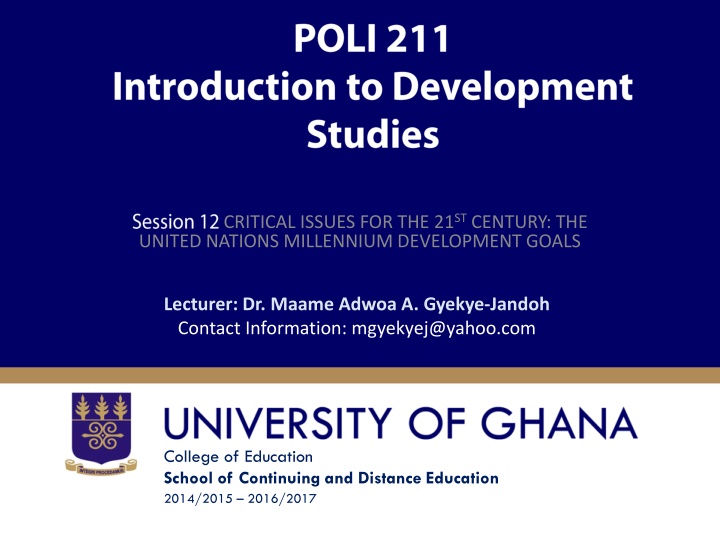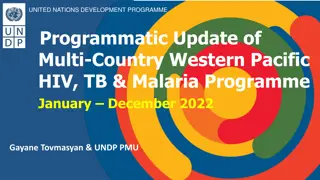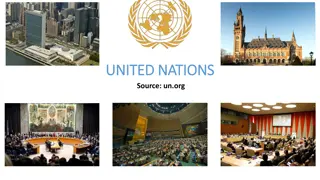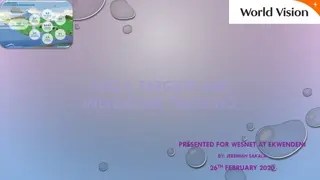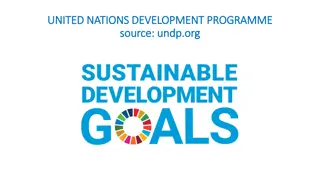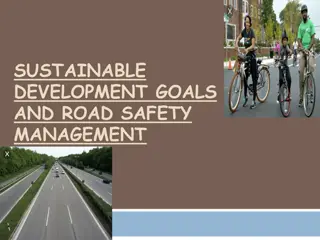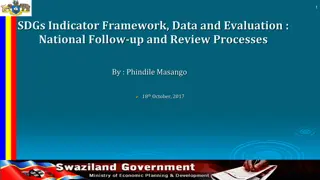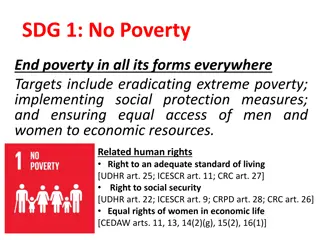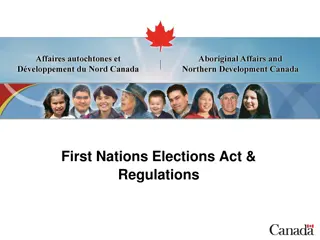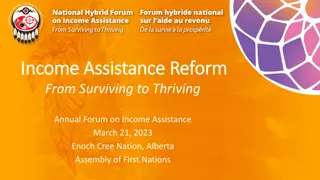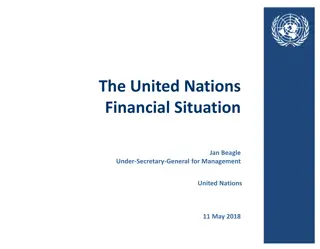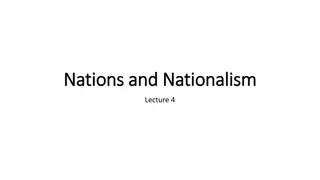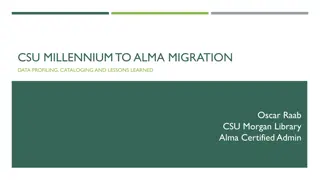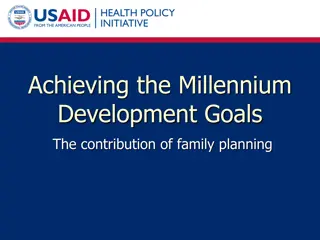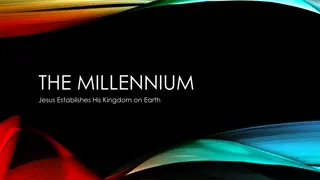United Nations Millennium Development Goals Overview
The United Nations Millennium Development Goals (MDGs) form a crucial blueprint aiming to reduce poverty and enhance development worldwide. This session explores the eight MDGs, their significance, achievements in Africa and Ghana, and future objectives through Sustainable Development Goals. Topics cover assessing progress, key readings, and understanding the interconnectedness of global development efforts.
Download Presentation

Please find below an Image/Link to download the presentation.
The content on the website is provided AS IS for your information and personal use only. It may not be sold, licensed, or shared on other websites without obtaining consent from the author.If you encounter any issues during the download, it is possible that the publisher has removed the file from their server.
You are allowed to download the files provided on this website for personal or commercial use, subject to the condition that they are used lawfully. All files are the property of their respective owners.
The content on the website is provided AS IS for your information and personal use only. It may not be sold, licensed, or shared on other websites without obtaining consent from the author.
E N D
Presentation Transcript
CRITICAL ISSUES FOR THE 21STCENTURY: THE UNITED NATIONS MILLENNIUM DEVELOPMENT GOALS Lecturer: Dr. Maame Adwoa A. Gyekye-Jandoh Contact Information: mgyekyej@yahoo.com College of Education School of Continuing and Distance Education 2014/2015 2016/2017
Session Overview Overview This final session will examine another avenue by which to develop the less developed countries: the United Nations Millennium Development Goals (MDGs). The MDGs form a blueprint agreed to by all the countries in the world and all the leading development institutions as their effort to meet the needs of the world s poorest people. The session will cover what the MDGs entail, what they have achieved in Africa and Ghana, and what they hope to achieve going forward through the Sustainable Development Goals (SDGs). Slide 2
Session Outline The key topics to be covered in this final session are as follows: Topic One: The United Nations Millennium Development Goals Topic Two: Assessing the Progress of the UN Millennium Development Goals in Africa and in Ghana Slide 3
Reading List Todaro, Michael. 2000. Economic Development. England: Pearson Education Limited. Michael Todaro and Stephen Smith. 2012. Economic Development. (11th edition). England: Pearson Education Limited. http://www.un.org/millennium goals/; UNDP-Ghana. 2010. UNDP-Ghana 2010 Report www.africaaction.org/african-initiatives/aaf3.htm http://digitalmedia.worldbank.org/projectsandops/st rategy.htm Slide 4
Topic One THE UNITED NATIONS MILLENNIUM DEVELOPMENT GOALS Slide 5
The United Nations Millennium Development Goals What are the Millennium Development Goals? In today s new world order, the future of all humankind is more closely linked today than ever before. This new order, some argue, should be based on the fundamental principle that each nation s and each individual s development is intimately bound to the development of every other nation and every other individual (Todaro 2000). The United Nations recognized the fact of the increasingly close links and increasingly common destiny of all humankind in the new millennium and agreed, in September 2000, on the need for the MDGs to reduce poverty and enhance development in the poorer part of the world. Slide 6
The Eight UN Millennium Development Goals (MDGs) Thus eight important goals were agreed on to be achieved in the new millennium, beginning in 2000 with results by 2015. These eight MDGs are: First, to eradicate extreme poverty and hunger. Second, to achieve universal primary education. Third, to promote gender equality and empower women. Fourth, to reduce child mortality. Fifth, to improve maternal health. Sixth, to combat HIV/AIDS, malaria, and other diseases. Seventh, to ensure environmental sustainability. Eighth, to develop a global partnership for development. Each of the goals was to be achieved by 2015. Slide 7
A Closer Look at the Eight UN MDGs Each MDG seeks to achieve something important. Let us look at teach MDG below. The first MDG, eradicating extreme poverty and hunger, hopes to reduce by half the proportion of people living on less than a dollar a day. It also aims at reducing by half the proportion of people who suffer from hunger. The second MDG, achieving universal primary education, aims to ensure that all boys and girls complete a full course of primary schooling. The third MDG, promoting gender equality and empowering women, hopes to eliminate gender disparity in primary and secondary education, preferably by 2005, and at all levels by 2015. Slide 8
A Closer Look at the Eight UN MDGs The fourth MDG, reducing child mortality, aims to reduce by two thirds the mortality rate among children under five. The fifth MDG, improving maternal health, hopes/aims to reduce by three quarters the maternal mortality rate. The sixth MDG, combating HIV/AIDS, malaria and other diseases, aims to halve and begin to reverse the spread of HIV/AIDS, as well as halve and begin to reverse the incidence of malaria and other major diseases. The seventh MDG, ensuring environmental sustainability, aims to integrate the principles of sustainable development into country policies and programs, and reverse the loss of environmental resources. It also aims at reducing by half the proportion of people without sustainable access to safe drinking water and basic sanitation, as well as achieving significant improvement in the lives of at least 100 million slum dwellers by 2020. Slide 9
The UN MDGs continued The eighth MDG, developing a global partnership for development, aims to develop further an open, rule-based, predictable, non- discriminatory trading and financial system. 2. It hopes to address the special needs of the least developed countries, landlocked countries, and small island developing states, and deal comprehensively with the debts of developing countries. 3. MDG 8 also aims at developing and implementing strategies for decent and productive work for youth in cooperation with developing countries. 4. In cooperation with pharmaceutical companies, it aims to provide access to affordable essential drugs in developing countries. And in cooperation with the private sector, it hopes to make available the benefits of new technologies, especially information and communications technologies. Slide 10
Conclusion to Topic One Thus, the UN MDGs are very concerned with eradicating poverty, providing life-sustenance, and in general improving the well-being of the individual, hallmarks of the humanist perspective of development that you studied earlier. Slide 11
Sample Questions Briefly explain how the first five MDGs can help to achieve development in the humanist perspective. Slide 12
Topic Two ASSESSING THE PROGRESS OF THE UN DEVELOPMENT GOALS IN AFRICA AND IN GHANA Slide 13
Assessing the Progress of the UN Millennium Development Goals in Africa and in Ghana The UN Millennium Development Goals: Progress in sub- Saharan Africa by the Midway Point, 2007 By 2007, which was the midway point between their adoption in 2000 and the 2015 target date for achieving the Millennium Development Goals, Sub-Saharan Africa, unfortunately, was not on track to achieve any of the Goals. Even the best governed African countries had not been able, by 2007, to make sufficient progress in reducing extreme poverty in its many forms. Let us examine each Goal below and the progress made by 2007. Slide 14
Assessing the Progress of the UN Millennium Development Goals in Africa and in Ghana Poverty and Hunger: With regard to this first goal, you should note that the proportion of people living on one dollar a day or less in Africa had declined by 2007 from 45.9 percent to 41.1 percent since 1999. Despite a high regional population growth rate of 2.3 percent a year, by 2007, the rising number of extreme poor had leveled off, increasing only marginally from 296 million in 1999 to 298 million in 2004. Education: By 2007, there had been progress towards universal primary education, with enrolment increasing from 57 percent in 1999 to 70 percent in 2005 but a gap of 30 percent remained, while the number of school age children continued to rise daily. In 2007, there were 348 million young people in sub-Saharan Africa under the age of 14, up from 237 million in 1990. This number was expected to reach 403 million by 2015. Slide 15
The Progress of the UN MDGs in Africa and in Ghana continued Gender Equality: Progress towards this third goal had been slow. Although the share of parliamentary seats held by women had increased substantially by 2007, from 7 percent in 1990 to 17 percent in 2007, the share of women earning a salary, apart from farming, still stood below one-third in 2005. Child Mortality: Under-five mortality rates dropped from 185 per 1000 live births in 1990 to 166 per 1000 in 2005. This drop hardly made any progress towards the objective of a two- thirds reduction by 2015, and was twice the rate in the developing world as a whole. One positive, however, was that due to extensive vaccination drives, measles cases and deaths fell by nearly 75 percent between 1999 and 2005. Slide 16
The Progress of the UN MDGs in Africa and in Ghana continued Maternal Health: This fifth goal remained a regional and global scandal, with the probability that a woman in sub- Saharan Africa will die from pregnancy complications and childbirth during her life at 1 in 16, in contrast to 1 in 3,800 in the developed world. AIDS and Other Diseases: Unfortunately, this goal had not made much progress by 2007. The number of people dying from AIDS continued to rise, reaching 2 million in 2006. Although prevalence rates had leveled off, the number of new cases, especially among women, as well as the number of people with advanced HIV infection continued to grow and rise faster than treatment services could be increased. In addition, there was no evidence that the very high rate of TB (tuberculosis) cases was starting to level off. Slide 17
Additional UN MDG Progress in Africa Environmental Sustainability: Regarding this seventh goal, only 42 percent of people in rural areas had access to clean water, and 63 percent of the entire sub-Saharan African population lacked basic sanitation facilities. This percentage was down only barely from 68 percent in 1990, and far from the target of dividing this proportion in half by 2015. In addition, the effects of climate change will only make achievement of the MDGs by African countries more difficult, because according to projections made by the Intergovernmental Panel on Climate Change, between 75 and 250 million people will experience an increase of water stress. If there is inadequate preparation, the impact on rural economies and the livelihoods of the poor could be devastating (UN Department of Public Information, June 2007). Slide 18
Success Stories in Africa Some Success Stories in Africa While Africa was the only region where the number of extreme poor had risen over the past fifteen years by 2007, it is less well known that major improvements in key development fundamentals had been experienced in many African countries. These include an annual economic growth rate averaging close to 6% since 2004, which was boosted by improved economic policies and rising commodity prices. This growth was spread quite evenly among countries. By 2007, there had also been a decrease in the number of civil conflicts with indications that the downward trend would continue. A third improvement was that current-account balances or balance of payment sheets were made better by receipts from exports, along with debt relief that reduced macroeconomic imbalances in the poorest countries. Businesses in Africa by 2007 were generating stronger domestic investment and productivity gains. Slide 19
Success Stories in Africa Many African governments continued to become less corrupt, more transparent, and more democratic. Note, however, that this progress in African developmental fundamentals remains weak, because it is fuelled mainly by a boom in commodity prices. Countries in Africa continue to depend on a few primary commodities for export and lack the essential public investments in agriculture, health, education, and infrastructure, that are needed to strengthen capacity for production and trade, sustain high growth rates and create employment. Slide 20
Progress of the UN MDGs in Ghana Let us examine the progress of the UN MDGs in Ghana more specifically. The MDGs were anchored and mainstreamed into successive Medium Term National Development Plans starting with the Ghana Poverty Reduction Strategy (GPRS I) 2003-2005, then the Growth and Poverty Reduction Strategy (GPRS II) 2006-2009, and recently, Ghana Shared Growth and Development 2010-1013. The progress towards meeting the MDGs is monitored on a regular basis. According to a UNDP (2010) report, the progress towards achieving the MDGs in Ghana is mixed. MDGs 1 and 2 have made significant progress and Ghana is likely to attain them by the target year 2015. Goal 6 is potentially achievable; goals 3 and 7 are likely to be partially achieved; while goals 4 and 5 are unlikely to be achieved despite showing marginal improvements. Slide 21
Progress of the UN MDGs in Ghana Overall, generally, Ghana has made some progress towards achieving the MDGs. There are still some targets in many of the Goals that need more work and funds in order to be achieved. However, note that for the first time, most nations of the world, making up the United Nations, have agreed on the fact that majority of the world s people are poor, and that disease, lack of education, gender disparities, environmental degradation, and lack of access to basic needs like water and good sanitation compound this poverty. For the first time, there is a global development plan that everyone is working to achieve. This is a groundbreaking event that will hopefully yield all the good fruits by 2015 and beyond. Slide 22
Questions to Consider Questions to consider: Briefly assess which of the MDGs have a very long way to go to achieve their target by the 2015 deadline, taking into account their progress by the halfway mark in 2007. Mention at least three key developmental fundamentals in which Africa was doing well by 2007, noting what still needs to be done for the improvements to be sustained. Slide 23
More Questions to Consider Questions to consider (continued): What would you say, generally, has been the overall progress of the MDGs in Ghana up to 2010? Using the references in your reading list and other sources, explain what the 17 UN Sustainable Development Goals (SDGs) are, and how they differ from the earlier MDGs, which formally came to an end in 2015. (Note that the SDGs were adopted in December 2015, dubbed as the next phase of developmental goals for the entire globe, not just developing countries. It is made up of 17 goals and 169 targets.) Slide 24
The UN Sustainable Millennium Development Goals (SDGs) 17 United Nations Sustainable Development Goals Goal 1: End poverty in all its forms everywhere Goal 2: End hunger, achieve food security and improved nutrition and promote sustainable agriculture Goal 3: Ensure healthy lives and promote well-being for all at all ages Goal 4: Ensure inclusive and equitable quality education and promote lifelong learning opportunities for all Goal 5: Achieve gender equality and empower all women and girls Goal 6: Ensure availability and sustainable management of water and sanitation for all Goal 7: Ensure access to affordable, reliable, sustainable and modern energy for all Goal 8: Promote sustained, inclusive and sustainable economic growth, full and productive employment and decent work for all Slide 25
The UN Sustainable Millennium Development Goals (SDGs) Goal 9: Build resilient infrastructure, promote inclusive and sustainable industrialization and foster innovation Goal 10: Reduce inequality within and among countries Goal 11: Make cities and human settlements inclusive, safe, resilient and sustainable Goal 12: Ensure sustainable consumption and production patterns Goal 13: Take urgent action to combat climate change and its impacts* Goal 14: Conserve and sustainably use the oceans, seas and marine resources for sustainable development Goal 15: Protect, restore and promote sustainable use of terrestrial ecosystems, sustainably manage forests, combat desertification, and halt and reverse land degradation and halt biodiversity loss Goal 16: Promote peaceful and inclusive societies for sustainable development, provide access to justice for all and build effective, accountable and inclusive institutions at all levels Goal 17: Strengthen the means of implementation and revitalize the global partnership for sustainable development Slide 26
Conclusion of Session 12 C In this final session of the course, the eight UN MDGs were introduced, as well as what exactly they hoped to achieve. We learned that sub-Saharan Africa had made some halting progress in the MDGs by 2007, and that much more needs to be done with respect to tackling poverty and the killer diseases especially. We, however, noted that Africa had seen some improvement in certain key development areas, such as annual economic growth rates averaging 6%, an improvement in business productivity, and some positive trend towards less corruption and more democracy. Progress was also made in Ghana with respect to the eight UN MDGs, particularly regarding Goals 1 and 2, and modest progress has been made in the others. A lot more work has to be done towards achieving Goals 5, 6, and 7. The 17 SDGs highlighted above embody the next global agreement billed to bring and sustain development and progress around the world. Slide 27
References Todaro, Michael. 2000. Economic Development. England: Pearson Education Limited. http://digitalmedia.worldbank.org/projectsandops /strategy.htm http://www.un.org/millennium goals/; UNDP- Ghana. 2010. UNDP-Ghana 2010 Report www.africaaction.org/african-initiatives/aaf3.htm UN Department of Public Information report, June 2007. Slide 28
